AWS Certified Developer - Associate
Databases
DynamoDB CLI Demo
In this lesson, you'll learn how to interact with Amazon DynamoDB using the AWS CLI. This tutorial covers creating tables, inserting and querying items, scanning tables with various options, and performing updates and deletes. In a future lesson, similar operations will be demonstrated using the AWS SDK, further expanding your understanding of DynamoDB operations.
Creating a Table
In this section, you'll create a DynamoDB table called review to store product reviews. The table features a simple key schema:
- Partition Key:
product(String) - Sort Key:
user(String)
We define these keys using the --attribute-definitions flag to specify data types and the --key-schema flag to denote each key's role (HASH for partition key and RANGE for sort key). The --provisioned-throughput flag sets the table's read and write capacity units as shown below.
Run the following command to create the table:
aws dynamodb create-table \
--table-name review \
--attribute-definitions \
AttributeName=product,AttributeType=S \
AttributeName=user,AttributeType=S \
--key-schema \
AttributeName=product,KeyType=HASH \
AttributeName=user,KeyType=RANGE \
--provisioned-throughput \
ReadCapacityUnits=2,WriteCapacityUnits=2
You can verify the table's creation with a scan command:
aws dynamodb scan --table-name products
To delete an item from another table (e.g., products), run:
aws dynamodb delete-item \
--table-name products \
--key '{ "id": {"S": "9999"} }'
After executing the create table command, refresh the DynamoDB console. Confirm that the new review table is listed with a partition key defined as product (String) and a sort key as user (String).
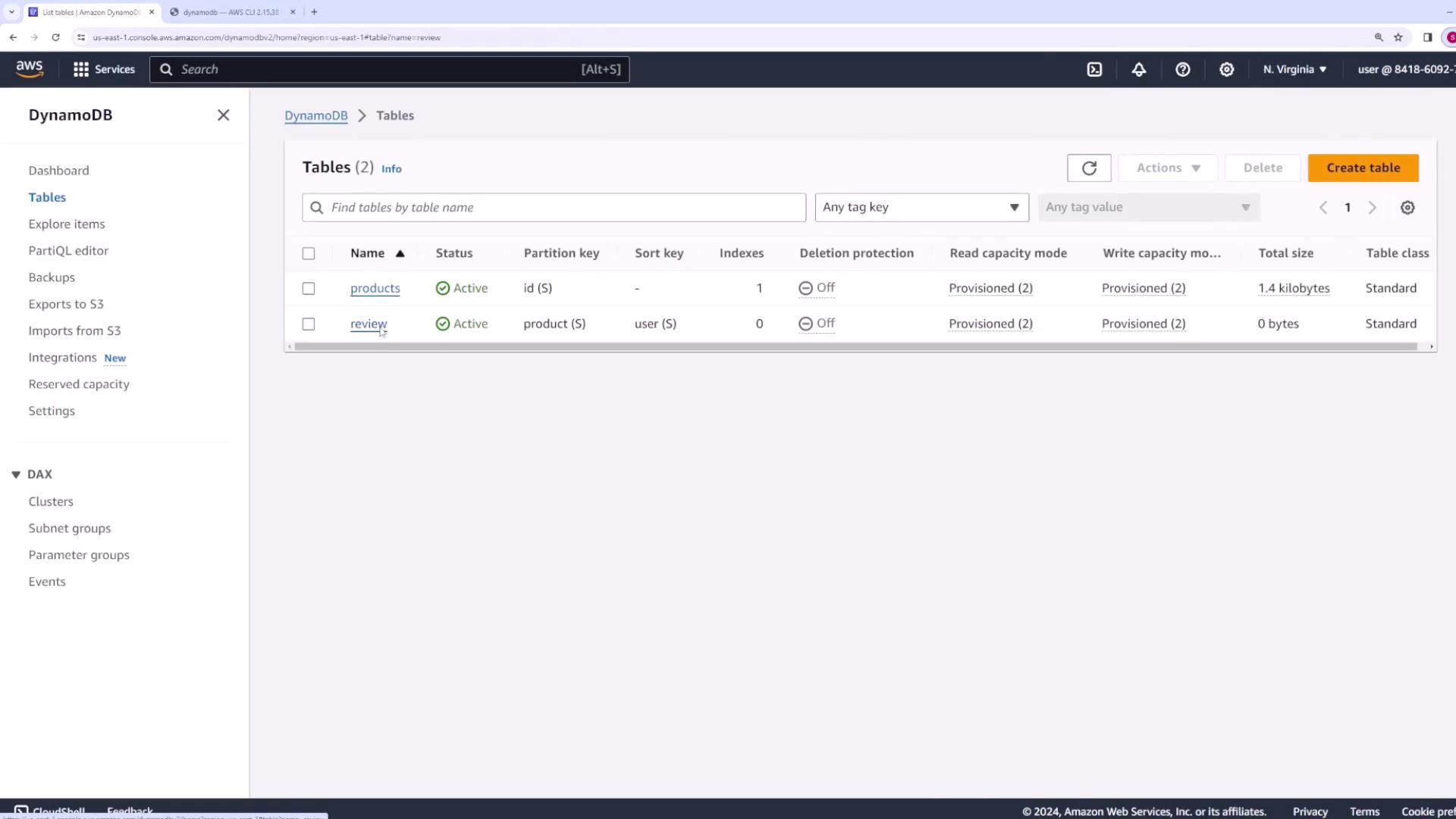
Exploring the Products Table
For this demo, we will work with an existing table called products. This table uses a single partition key and includes additional attributes:
id– Unique identifier (String)name– Product namecategory– Type of product (e.g., electronics, appliance, hardware)price– Product price (Number)onSale– Boolean indicating if the product is on saleinventory– Stock quantity (Number)
The following image shows a representation of the table in the DynamoDB console:
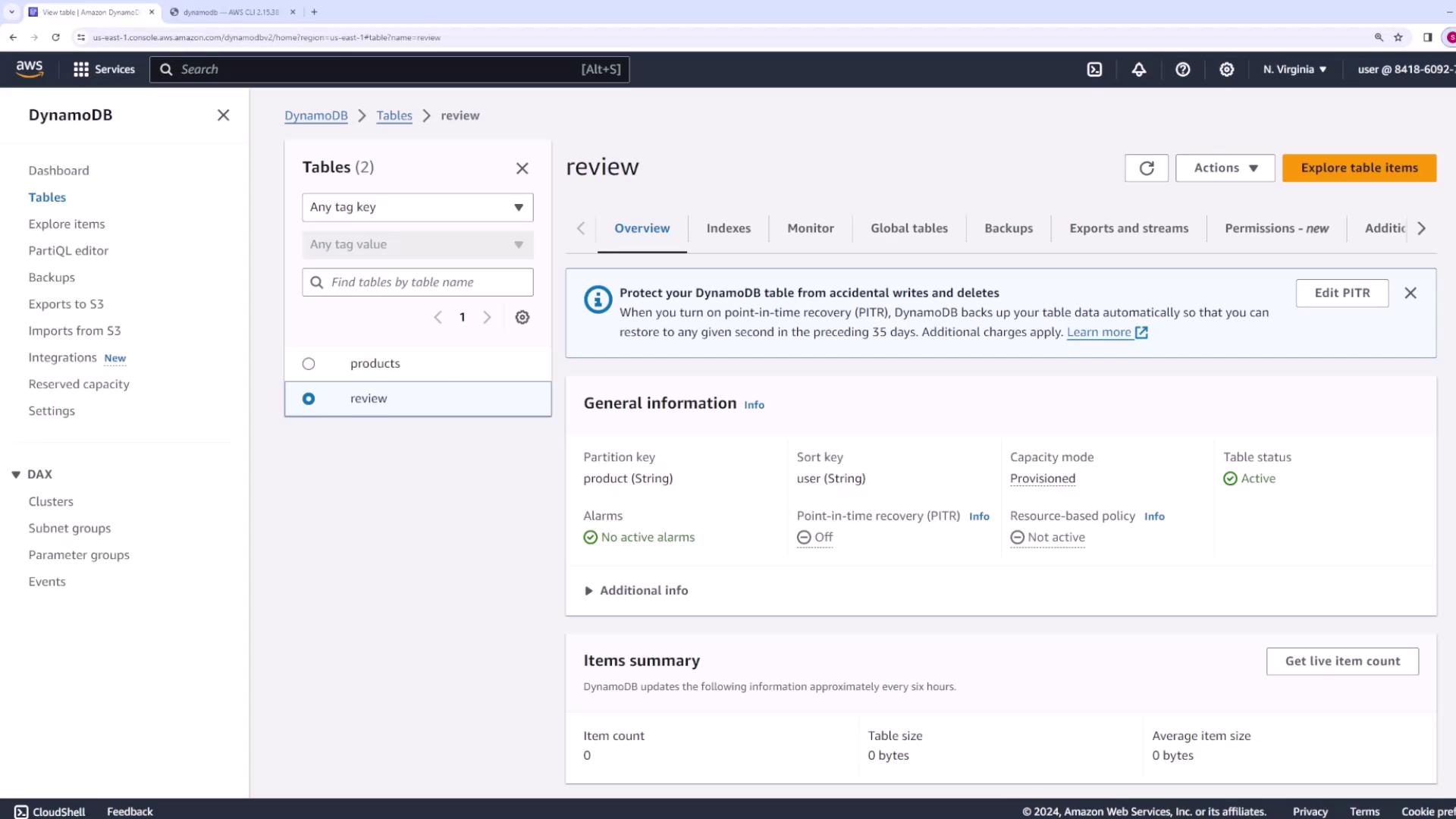
And the items in the table appear similar to this:
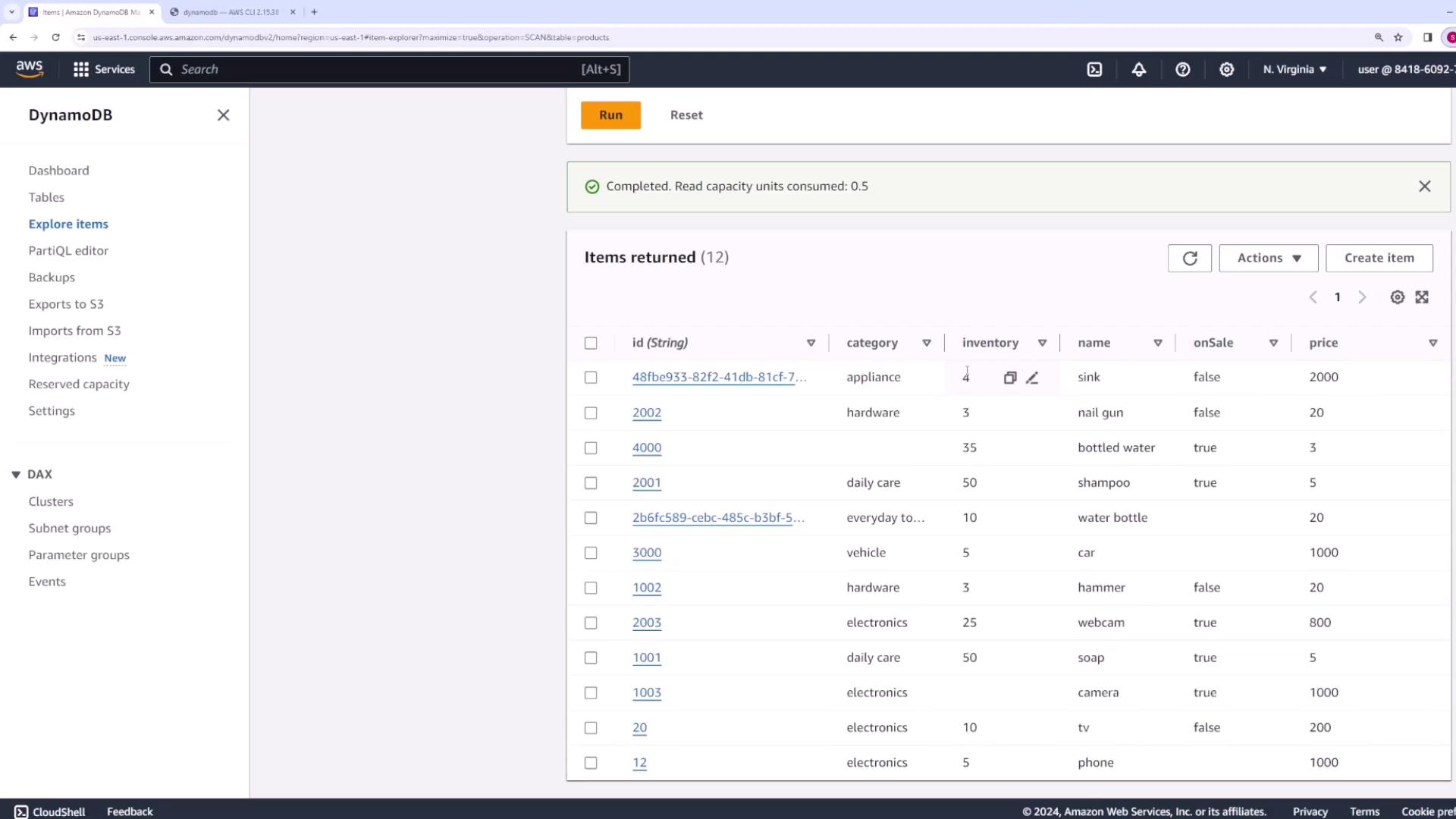
Scanning a Table
Scanning is the simplest operation to retrieve all items from a table. Although scanning can be resource-intensive for large datasets, it is perfect for demonstrations or small datasets.
Basic Scan
Run a basic scan to retrieve items:
aws dynamodb scan --table-name products
You can limit the number of returned items by using the --max-items flag:
aws dynamodb scan --table-name products --max-items 2
This command returns a JSON structure with details such as Items, Count, and ScannedCount.
Example JSON output:
{
"TableSizeBytes": 0,
"ItemCount": 0,
"TableArn": "arn:aws:dynamodb:us-east-1:841869027337:table/review",
"TableId": "89e7d77d-fd06-4c5e-9b77-1e151e3081b3",
"DeletionProtectionEnabled": false
}
After executing the scan, you'll see an array of items with attributes such as id, name, price, inventory, and onSale.
A sample command output might resemble:
databases\dynamodb\cli on ☁ (us-east-1) took 4s
indicating that the command executed successfully.
Pagination with Scan
For larger datasets, pagination retrieves items in batches. DynamoDB provides a NextToken when additional results are available. Retrieve the next batch with:
aws dynamodb scan --table-name products --max-items 2 --starting-token <token>
Replace <token> with the token returned in the previous scan. Continue paginating until no token is returned.
Using Projection Expressions
To minimize data transfer, you can retrieve only specific attributes. For example, to fetch only the id, price, and category attributes:
aws dynamodb scan --table-name products --projection-expression "id, price, category"
You can combine projection expressions with pagination as needed.
Filtering Items with Scan
DynamoDB supports client-side filtering. For instance, to retrieve only products belonging to the electronics category, use a filter expression. Although filtering reads all items, it returns only those that match the specified condition.
Run the following command:
aws dynamodb scan --table-name products \
--filter-expression "category = :category" \
--expression-attribute-values '{":category":{"S":"electronics"}}'
This command uses the placeholder :category with its value defined in the --expression-attribute-values flag. You can also combine this with projection expressions:
aws dynamodb scan --table-name products --projection-expression "id, price, category"
aws dynamodb scan --table-name products \
--filter-expression "category = :category" \
--expression-attribute-values '{":category":{"S":"electronics"}}'
After executing the command, only items where the category equals electronics will be displayed.
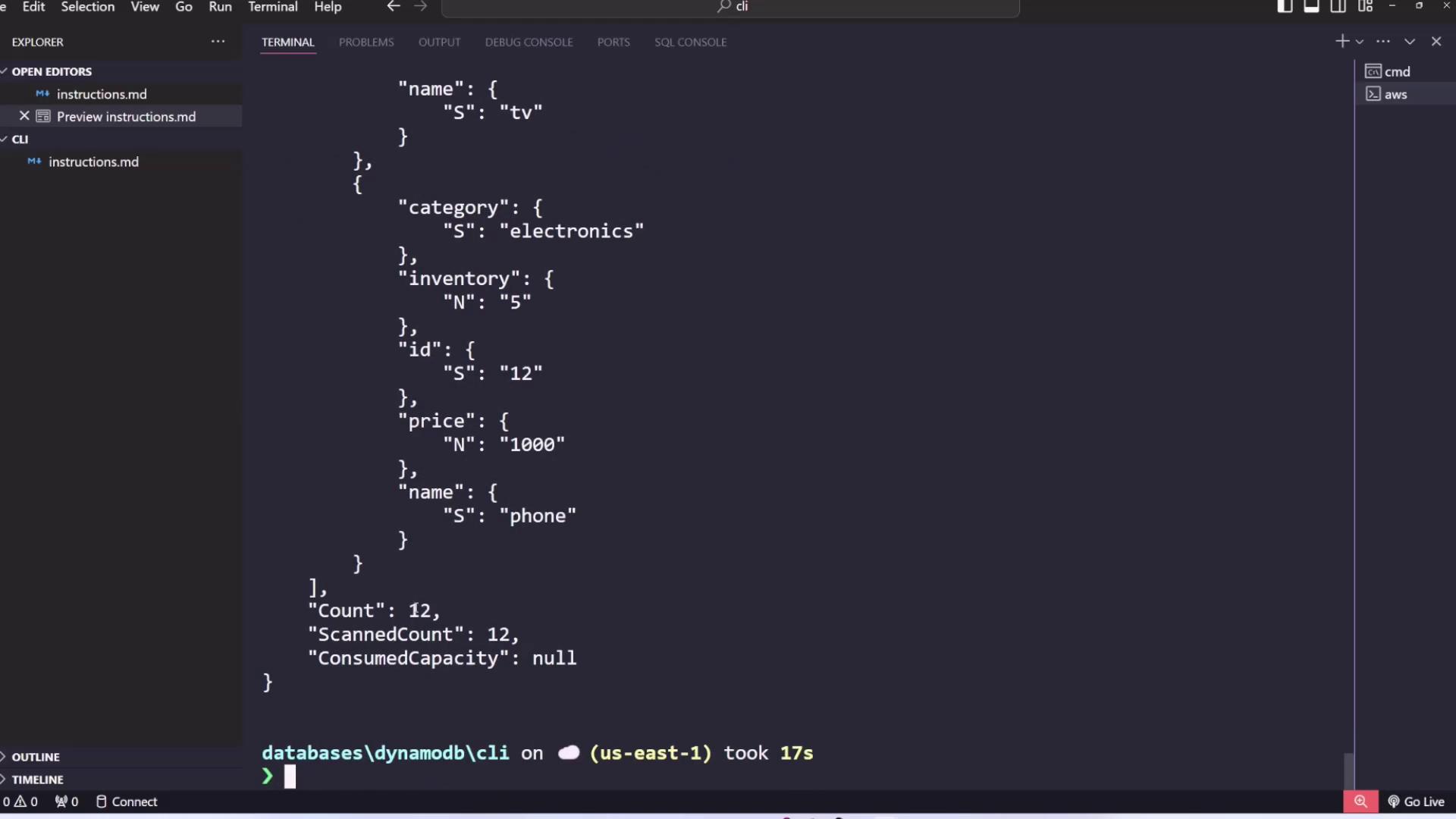
Querying a Table
For efficient data retrieval when key values are known, use the query operation. In this demo, an index is configured with the partition key category to allow efficient queries by product category.
Query the products table for all electronics items using the following command:
aws dynamodb query \
--table-name products \
--index-name category-index \
--key-condition-expression "category = :category" \
--expression-attribute-values '{":category":{"S":"electronics"}}'
This query retrieves only the items that match the partition key condition. For retrieving a specific item, use the get-item command:
aws dynamodb get-item --table-name products --key '{"id": {"S": "20"}}'
This command returns detailed information about the item with an id of "20". If your table uses both a partition and sort key, include both in the command.
Example output:
{
"id": {
"S": "12"
},
"name": {
"S": "phone"
}
}
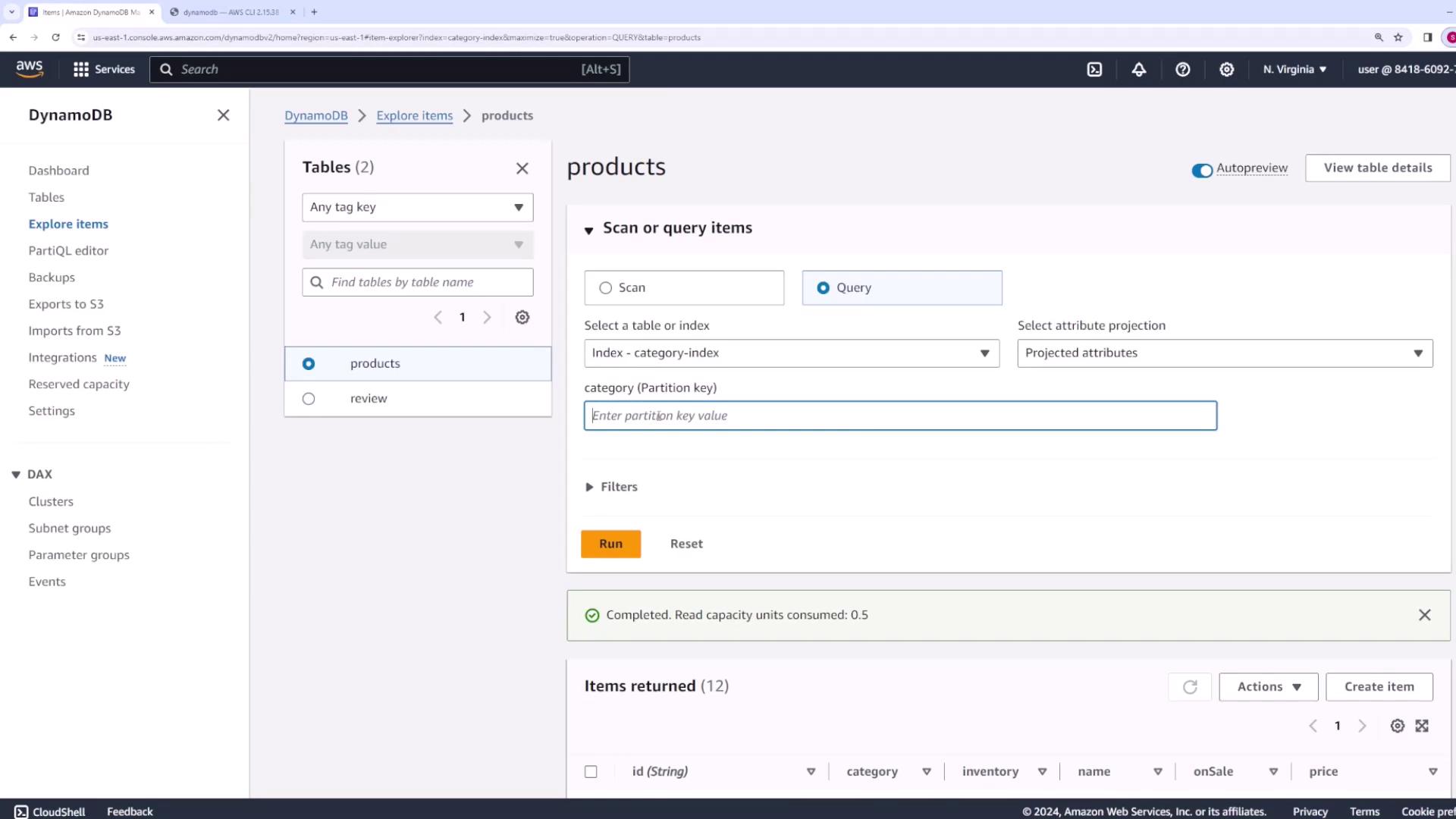
Creating, Updating, and Deleting Items
Put Item
To insert a new item into the products table, use the put-item command. For example, to add a new product:
aws dynamodb put-item --table-name products --item '{
"id": {"S": "9999"},
"name": {"S": "keyboard"},
"price": {"N": "500"},
"category": {"S": "electronics"}
}'
Note
If you rerun the put-item command to update an existing item (for example, adjusting the price), you must include all attributes to avoid unintentionally deleting any attribute. In the example below, the entire item is replaced with the updated attributes:
aws dynamodb put-item --table-name products --item '{
"id": {"S": "9999"},
"name": {"S": "keyboard"},
"price": {"N": "400"},
"category": {"S": "electronics"}
}'
Omitting an attribute during the update will result in that attribute being removed from the item.
Delete Item
To remove an item from the table, use the delete-item command and specify the primary key. For example:
aws dynamodb delete-item \
--table-name products \
--key '{ "id": {"S": "9999"} }'
After executing this command, refresh the table to confirm that the item with an id of "9999" has been removed.
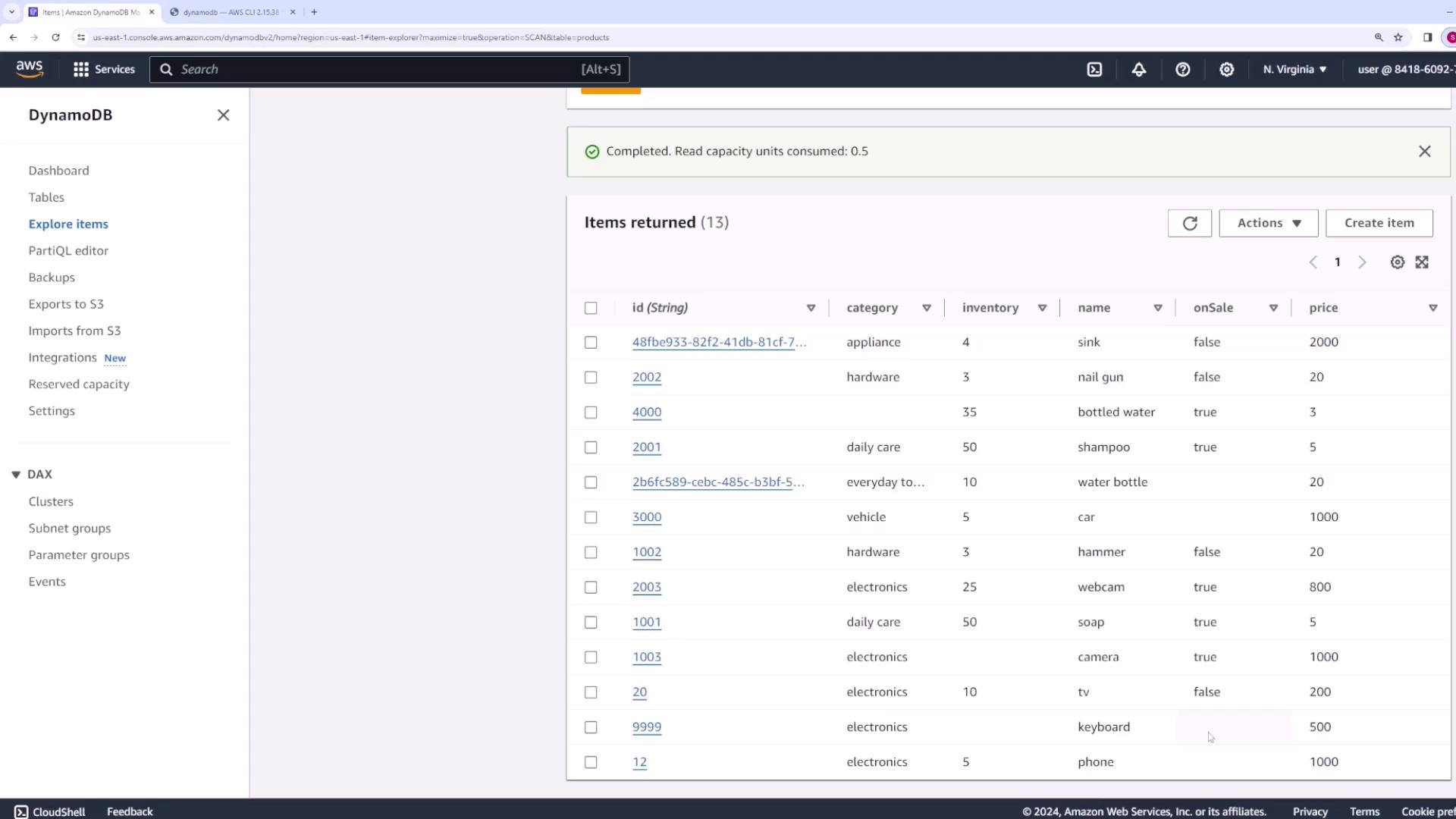
Summary
In this lesson, you learned how to:
- Create a DynamoDB table using the AWS CLI with a specified key schema and provisioned throughput.
- Scan a table to retrieve all items, implement pagination, utilize projection expressions, and apply client-side filtering.
- Use the query command for efficient data retrieval when indexes are available.
- Retrieve specific items with the get-item command.
- Insert new items using put-item, update existing items by replacing them, and remove items using delete-item.
These commands form the foundation of interacting with DynamoDB via the CLI. As you progress in your development, consider exploring additional options such as condition expressions and update commands to handle more complex business logic.
Happy coding, and see you in the next lesson!
Watch Video
Watch video content